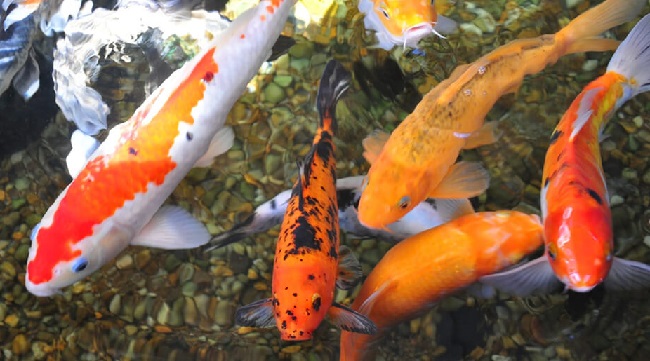When it comes to visual allure in the world of ornamental fish, Koi fish stand unrivaled. Renowned for their brilliant hues and distinct patterns, Koi fish embody a blend of natural aesthetics and symbolic meaning.
But what are the different Colors of Koi fish, and what do these colors signify? In this comprehensive guide, we’ll navigate the vibrant palette of Koi fish, providing you with in-depth knowledge of these colorful aquatic creatures.

Koi Fish Colors: A Spectrum of Significance
Koi fish come in a wide range of colors, each associated with its own unique meaning. These include white, black, red, yellow, blue, and a multitude of color combinations.
Kohaku: The Red and White Beauty
The most recognized variety of Koi is the Kohaku, which displays a captivating combination of white and red. The white base is complemented by red patterns, symbolizing the harmony between two powerful forces. This pattern is viewed as the embodiment of love and success in Japanese culture.
Taisho Sanke: The Three-Colored Koi
The Taisho Sanke Koi boasts a white body with red and black spots. These three colors represent the blend of positivity (white), passion (red), and transformation (black). This combination is believed to attract good fortune and ward off evil spirits.
Showa Sanshoku: The Tri-Colored Beauty
The Showa Sanshoku Koi exhibits a black body adorned with red and white markings. This color mix is symbolic of change and the courage to overcome life’s obstacles.
Ogon: The Single-Colored Koi
Ogon Koi are known for their solid metallic colors, such as gold, silver, and platinum. They symbolize wealth, prosperity, and success.
Bekko: The Turtleshell Koi
The Bekko variety showcases a solid white, red, or yellow base covered with black spots. This pattern resembles a turtle shell, representing longevity and endurance.
Interpreting Koi Fish Patterns
Understanding Koi fish colors involves more than recognizing the primary hues. It also includes distinguishing the unique patterns that each Koi exhibits. For instance, a “Tancho” pattern refers to a Koi that has a single red spot on its head. This pattern is particularly adored, as it mirrors the Japanese flag.
Koi Color and Quality: What You Need to Know
The intensity and clarity of a Koi’s colors often indicate its quality and health. High-quality Koi have vibrant, uniform colors with clear separations between different color areas. Over time, a Koi’s color may change due to factors such as age, diet, water quality, and sunlight exposure.
Conclusion
The diverse Colors of Koi fish hold a deep-seated significance in Japanese culture, symbolizing various aspects of life, from love and success to change and endurance.
Understanding these colors and their implications can enhance your appreciation for these majestic aquatic creatures.
As you delve deeper into the world of Koi, remember that their radiant colors are more than just a feast for the eyes – they are a vibrant testament to the rich cultural tapestry from which these fish originate.
























